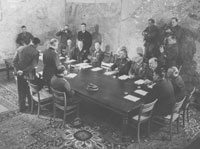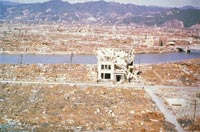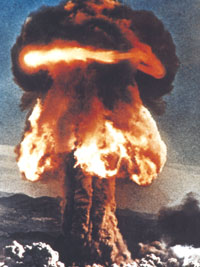|
World
Aviation in 1945
1 January
Operation Bodenplatte: the Luftwaffe's last major attack
attempts to destroy the maximum number of Allied aircraft on
the ground. 800 Luftwaffe aircraft are involved in this
surprise attack and a total of 465 Allied aircraft are
destroyed or damaged. More than 220 Luftwaffe aircraft are
lost during the operation.
16 January
Allied air and ground operations force the German bulge
forces in the Ardennes to retreat.
13-15 February
Royal Air Force (RAF) and United States Army Air Force (USAAF)
night and day bombers attack Dresden in Germany. These
attacks create a fire storm which virtually destroys the
city. Estimates of the dead vary from 35,000 to 220,000.
16 February
United States Army Air Force (USAAF) C47s drop more than
2,000 paratroopers on Corregidor. The island has already been
'softened up' by a major bombardment of Japanese positions.
17 February
Softening up operations begin against Iwo Jima. United States
Navy (USN) carrier aircraft and naval guns combine with the
7th United States Army Air Force (USAAF) Consolidated B24
Liberators to pound Japanese positions.
19 February
United States Marines, with massive air and sea bombardment
support, begin landing on Iwo Jima.
21 February
The American carrier USS Saratoga is hit and badly damaged by
a Kamikaze attack.
23 February
The German Air Force sinks its last ship of the Second World
War; the Henry Bacon belonging to convoy RA64.
28 February
The first manned flight of the Bachem Ba349 Natter kills the
pilot, Oberleutnant Lothar Siebert. Three subsequent manned
launches are successful and the aircraft is approved for
operational use, although it will not see service.
March 9
German forces, including air units, continue to attack the
bridge at Remagen in an effort to eliminate this allied
bridgehead over the Rhine.
9-10 March
279 Marianas-based Boeing B29s begin a new campaign of
low-altitude incendiary night attacks against Japanese cities
with an attack on Tokyo.
16 March
Japanese resistance on Iwo Jima ends, but is a costly
victory, with 6,891 Marines killed and another 18,070
injured. It proves a very useful emergency landing ground
with 2251 Boeing B29s finding refuge here before the war
ends.
17 March
307 Boeing B29s drop 2,300 tons of incendiaries on Kobe in
Japan.
18 March
The largest United States Army Air Force (USAAF) daylight
raid on Berlin takes place, with 1,250 bombers and an escort
of 670 fighters.
20-21 March
The Luftwaffe mounts its last manned aircraft attack on the
United Kingdom.
21 March
The first, unsuccessful, sortie is made by Japanese Yokosuka
Ohka suicide aircraft.
21-24 March
A combined effort by Allied air forces in Europe is mounted
against the Luftwaffe and its bases and virtually destroys
the Luftwaffe as an effective force.
23-24 March
Allied forces make large scale crossings of the Rhine in
Operation Varsity, which sees a large scale Allied airborne
landing take advanced positions.
27 March
The last V2 rocket to fall on the United Kingdom lands at
Orpington in Kent at 1654hrs, killing one person and injuring
23 others.
31 March
The British Commonwealth Air Training Plan officially ends.
137,739 trainees have passed through, of which 54,098 are
pilots. In addition, over 155,000 air crew members were
trained in Britain, Australia, New Zealand, South Africa and
Southern Rhodesia. Over 14,000 British air crew members were
trained in the United States.
1 April
Japanese Ohka suicide aircraft score their first major
successes, when they severely damage the battleship USS West
Virginia and three other vessels. One of those other vessels
is the British carrier HMS Indefatigable.
7 April
The 71,000 ton Japanese battleship 'Yamato', a cruiser, and
four of eight destroyers are sunk by endless air attacks from
United States Navy (USN) carrier aircraft as they fruitlessly
attempt to disrupt the United States landings on Okinawa.
7 April
United States Army Air Force (USAAF) Boeing B29s receive
fighter escort for all future missions against the Japanese
Home Islands.
10 April
The last wartime sortie over the United Kingdom is made by an
Arado Ar234B reconnaissance aircraft operating from Norway.
10 April
In an attack on targets in the Berlin area the United States
Army Air Force (USAAF) loses 19 bombers and 8 fighters to
German Messerschmitt Me262 jet fighters.
12 April
 The destroyer USS Mannert
L. Abele is sunk by a Japanese Ohka suicide aircraft off
Okinawa. The destroyer USS Mannert
L. Abele is sunk by a Japanese Ohka suicide aircraft off
Okinawa.
18 April
At the request of the United States, Spain prohibits the
landing of all German aircraft on Spanish territory.
19 April
The International Air Transport Associaition (IATA) is formed
at Havana in Cuba.
23 April
United States Navy Consolidated PB4Y Liberators of Patrol
Bombing Squadron 109 launch two Bat missiles against Japanese
shipping in Balikpapan harbour in Borneo. This is the first
use of automatic homing missiles during the Second World War.
26 April
Hanna Reitch, flying a Fiesler Fi156 Storch, flies General
Ritter von Greim from Berlin, Gatow into Berlin. In Hitler's
underground bunker he is promoted to command the Luftwaffe in
place of Hermann Göring.
28 April
Benito Mussolini is captured at Dongo, near Lake Como and is
shot by Italian Communist partisans.
29 April
The war in Italy comes to an end with German envoys signing
terms of unconditional surrender.
30 April
Adolf Hitler and Eva Braun commit suicide in the air raid
bunker beneath the German Chancellery in Berlin.
7 May
 Documents
for the unconditional surrender of all German forces are
signed at General Eisenhower's Headquarters. Ratified in
Berlin, the war in Western Europe ends officially at
midnight. Documents
for the unconditional surrender of all German forces are
signed at General Eisenhower's Headquarters. Ratified in
Berlin, the war in Western Europe ends officially at
midnight.
22 May
United States authorities disclose that Japanese balloon
attacks have been, and continue to be made on the United
States. One ballon had come down in Montana and another in
British Columbia
29 May
An advance party of the 509th Composite Group of the United
States Army Air Force (USAAF) arrives in the Mariana Islands.
31 May
The United States War Department announces that a woman and
five children have been killed by a Japanese bomb-carrying
balloon on 5 March at Lake View in Oregon.
11 June
Boeing B29s of the 393rd Very Heavy Bomber Squadron, the only
combat aircraft of the 509th Composite Group, land at Tinian
in Marianas.
25 June
The National Skyway Freight Corporation is established as the
first all freight airline in the USA. In 1946 it will adopt
the title Flying Tiger Line Inc.
1 July
With air support from the Royal Australian Air Force (RAAF)
and the 5th and 13th United States Army Air Force (USAAF),
the Australian 7th division lands on the South-east coast of
Borneo.
2 July
Japanese authorities begin a major evacuation of people from
Toyko, due to heavy and continuous air attacks by the
Americans.
10 July
The final United States aircraft carrier operations begin
against targets on the Japanese home islands.
11 July
The United States announces the transfer of the 8th United
States Army Air Force (USAAF) via the United States to the
Far East.
13/14 July
The Supreme Headquarters of the Allied Expeditionary Forces
is disbanded at midnight.
14 July
United States Army Air Force (USAAF) Douglas A20s operating
from Hollandia attack Japanese-held oil fields at Boela on
Ceram Island. They use rocket bombs for the first time in the
southwest Pacific.
16 July
The first atom bomb is successfully detonated at Alamogordo
in New Mexico in the United States.
16 July
Major General Curtis LeMay takes command of the 20th United
States Army Air Force (USAAF).
21 July
Japanese forces are decimated by air attacks as they attempt
to retreat across the Sittang river in Burma.
28 July
A North American B25 Mitchell bomber of the United States
Army Air Force (USAAF), flying in bad visibility, collides
with the 79th floor of the Empire State Building in New York.
19 people are killed, including the crew of six, and
twenty-six people are injured.
30 July
The Mediterranean Allied Air Forces are disbanded.
1 August
851 Boeing B29s mount the largest operation against Japanese
cities.
6 August
 Boeing
B29 'Enola Gay' of the 509th Composite Group, piloted by
Colonel Paul W. Tibbets Jr, drops the world's first
operational atomic bomb over the city of Hiroshima. The bomb
is dropped at 0815hrs local time at a height of 1,900 feet
and generates a yield equivalent to 12,500 tons of TNT. Boeing
B29 'Enola Gay' of the 509th Composite Group, piloted by
Colonel Paul W. Tibbets Jr, drops the world's first
operational atomic bomb over the city of Hiroshima. The bomb
is dropped at 0815hrs local time at a height of 1,900 feet
and generates a yield equivalent to 12,500 tons of TNT.
Of the 76,000 buildings in
Hiroshima, 48,000 were destroyed and 22,000 damaged. The bomb
destroyed 4.7 square miles of the city and over 80% of its
buildings. Japanese estimates put casualties at 71,379 killed
or missing and 68,023 wounded.
9 August
 Lieutenant Robet H.
Gray of the Royal Canadian Naval Volunteer Reserve (RCNVR) is
killed attacking a Japanese destroyer. Attached to the Fleet
Air Arm and flying a Corsair, he is posthumously awarded the
last air force Victoria Cross to be won. Lieutenant Robet H.
Gray of the Royal Canadian Naval Volunteer Reserve (RCNVR) is
killed attacking a Japanese destroyer. Attached to the Fleet
Air Arm and flying a Corsair, he is posthumously awarded the
last air force Victoria Cross to be won.
9 August
 A
second atomic bomb is dropped over Nagasaki from Major
Charles W. Sweeney's Boeing B29 'Bock's Car'. The primary
target is Kokura but weather over this city forces a
diversion to the secondary target. A
second atomic bomb is dropped over Nagasaki from Major
Charles W. Sweeney's Boeing B29 'Bock's Car'. The primary
target is Kokura but weather over this city forces a
diversion to the secondary target.
Due to the topography of
Nagasaki with its hills and rivers, damage was far less than
Hiroshima. However, 1.4 square miles of a built up area of
3.8 square miles was destroyed. Japanese estimates, which
were comparatively low, put the casualties at 25,680 killed
and 23,345 wounded.
14 August
754 Boeing B29s and 169 fighters are sent on the last wartime
mission of the 20th United States Army Air Force (USAAF).
14-15 August
The unconditional surrender of Japan is announced.
15 August
Seven Japanese suicide aircraft make the last Kamikaze attack
of the war.
15 August
Andrei G. Kochetkov, Head of NII-VVS Fighter Testsection,
becomes the first Soviet pilot to fly a jet powered aircraft,
a captured Messerschmitt Me262A, at Shcholkovo near Moscow.
19 August
Two Mitsubishi G4M 'Betty' transports carry the Japanese
surrender delegation to Ie Shima.
21 August
All existing United States Lend-Lease contacts are cancelled.
September
A captured Focke Achgelis Fa223 'Drache' helicopter, flown by
an ex-Luftwaffe crew, becomes the first helicopter to cross
the English Channel.
2 September
Surrounded by the United States Pacific Fleet, the Japanese
sign surrender documents aboard the battleship USS Missouri,
anchored in Tokyo Bay.
10 September
USS Midway, the first of the United States Navy's 45,000 ton
class carriers is commissioned at Newport News in Virginia.
6 November
Flying the mixed power plant Ryan FR1 Fireball, which has a
conventional piston engine and a turbojet engine in the rear
fuselage, Ensign J.C. West uses the jet engine only to make
the world's first turbojet-powered landing on an aircraft
carrier, the USS Wake Island.
29 November
The first air-sea rescue by helicopter takes place when
seamen are rescued from an oil barge by a Sikorsky R5 at Long
Island Sound.
4 December
The United Kingdom government agrees to supply military
equipment to the French Air Force and Navy. |
